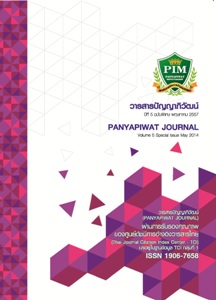การเปรียบเทียบปัจจัยที่ทำให้นักศึกษาไทยเลือกเรียนเป็นวิชาโท ระหว่างวิชาภาษาญี่ปุ่นกับภาษาจีน
Main Article Content
บทคัดย่อ
บทคัดย่อ
งานวิจัยนี้ มีวัตถุประสงค์เพื่อศึกษาเปรียบเทียบปัจจัยที่มีอิทธิพลต่อการตัดสินใจของนักศึกษาไทยที่เลือกเรียนระหว่างวิชาภาษาญี่ปุ่นและวิชาภาษาจีนเป็นวิชาโท กลุ่มประชากรประกอบด้วยนักศึกษาจำนวน 124 คนที่กำลังศึกษาในระดับปริญญาตรีชั้นปีที่ 2 สถาบันการจัดการปัญญาภิวัฒน์ เครื่องมือหลักในการวิจัยเชิงปริมาณนี้ คือ แบบสอบถามที่ใช้ในระหว่างการเรียนการสอนและการใช้การวิเคราะห์ปัจจัย นอกจากนี้ ยังมีการจัดประเภทปัจจัยแต่ละตัวให้อยู่ในข้อกำหนด 5 ประการ ตามรูปแบบการกระตุ้นภายในหรือภายนอก ผลการวิจัยพบว่า ปัจจัยที่ทำให้นักศึกษาไทยเลือกเรียนภาษาจีนมากกว่าภาษาญี่ปุ่น คือ แรงจูงใจภายใน ในขณะที่นักศึกษาไทยที่เลือกเรียนวิชาภาษาญี่ปุ่นเลือกด้วยแรงจูงใจเชิงสังคม ยิ่งไปกว่านั้น ยังมีผลการวิจัยอีกประการหนึ่งว่า กลุ่มผู้เรียนภาษาญี่ปุ่นเชื่อว่าการเรียนภาษาญี่ปุ่น และการบรรลุผลสัมฤทธิ์ในการเรียนภาษาญี่ปุ่นนั้น ยากกว่าเมื่อเทียบกับการเรียนภาษาจีน
Article Details
“ข้าพเจ้าและผู้เขียนร่วม (ถ้ามี) ขอรับรองว่า บทความที่เสนอมานี้ยังไม่เคยได้รับการตีพิมพ์และไม่ได้อยู่ระหว่างกระบวนการพิจารณาลงตีพิมพ์ในวารสารหรือแหล่งเผยแพร่อื่นใด ข้าพเจ้าและผู้เขียนร่วมยอมรับหลักเกณฑ์การพิจารณาต้นฉบับ ทั้งยินยอมให้กองบรรณาธิการมีสิทธิ์พิจารณาและตรวจแก้ต้นฉบับได้ตามที่เห็นสมควร พร้อมนี้ขอมอบลิขสิทธิ์บทความที่ได้รับการตีพิมพ์ให้แก่สถาบันการจัดการปัญญาภิวัฒน์หากมีการฟ้องร้องเรื่องการละเมิดลิขสิทธิ์เกี่ยวกับภาพ กราฟ ข้อความส่วนใดส่วนหนึ่งและ/หรือข้อคิดเห็นที่ปรากฏในบทความข้าพเจ้าและผู้เขียนร่วมยินยอมรับผิดชอบแต่เพียงฝ่ายเดียว”
References
Bureau of International Cooperation Strategy, The Office of the higher Education Commission Ministry of Education, Thailand. (2010). Strategy for Promoting Chinese Education in Thailand.Bangkok: Bangkok Block Co.,Ltd.
Confucius Institute Online. (n.d.). Worldwide Confucius Institute. Retrieved May 5, 2013, from http://www.chinesecio.com/m/cio wci
Deci, E. l., & Ryan, R. (2000). Intrinsic and extrinsic motivations: classic definitions and new directions. Contemporary Educational Psychology, 25, 54-67.
Deci, E. L. & Ryan, R. M. (1985). Intrinsic motivation and self-determination in human behavior.New York: Plenum.
Dörnyei, Z. (2001). Motivational Strategies in the Language Classroom. Cambridge: Cambridge University Press.
Embassy of the People's Republic of China in Royal Thai. (2011). Bilateral Relations. Retrieved June 12, 2013 from http://www.chinaembassy.or.th/eng/ztgxgxgk/t839942.htm
Ethnologue. (1999). Top 100 Languages by Population. Retrived Aug 8, 2013 from http://paginaspersonales.deusto.es/abaitua/konzeptu/nlp/top100.htm
Gardner, R. C., & Lambert, W. E. (1972). Attitudes and motivation in second language learning.Rowley, MA: Newbury House.
Gardner, C. Robert and Lambert, E. Wallace. (1959). Motivational variables in second language acquisition. Canadian Journal of Psychology, 13, 266-272.
Guo, J., & Quan, K. (2006). Motivation of Chinese University Students towards Learning Japanese.Journal of the international exchange Support Center 2006, 2, 118-128.
Hiromori, T. (2003). What Enhances Language Learners' Motivation? - High school English learners' motivation from the perspective of Self-Determination Theory -JALT Journal, 25 (2), 173-186.
Ministry of Foreign Affairs of Japan. (2012). MOFA: Japan-Thailand Relations (Basic Data). Retrieved June 12, 2013 from http://www.mofa.go.jp/region/asia-paci/thailand/data.html
Narita, T. (1998). The Relationship Between Motivation of Japanese-Language Learning and Achievement - In case of the University student in Thailand - Journal of Japanese-Language Education in the world, 8, 1-11.
Noels, K. A., Pelletier, L., Clement, R., & Vallerand, R. (2000). Why are you learning a second language? Motivational orientations and self-determination theory. Language Learning, 50,57-85.
Nuibe, Y., Kano, F., & Ito, K. (1995). International Survey on university Student Motivation - In case of Victoria University in New Zealand -- Journal of Japanese-Language Education, 86, 162-172
The Japan Foundation. (2013). Survey Report on Japanese-Language Education Abroad 2012 Excerpt. Tokyo: Kuroshio Publishers.
The Japan Foundation. (2011). Present Condition of Overseas Japanese-Language Education,Survey Report on Japanese-Language Education Abroad 2009 Excerpt. Tokyo: The Japan Foundation.
Utsugi, T. (2011). The relationship between the ability of Japanese language and the motivation of learning Japanese language, conduct a survey of university students in Thailand.Journal of Japanese Language Education The Japan foundation Bangkok, 8, 65-74.
Ostapirat, W. (2005). Kra-dai and Austronesian: notes on phonological correspondences and vocabulary distribution [language families). In L. Sagart, R. Blench and A. Sanchez-Mazas (Ed.), The peopling of East Asia: putting together archaeology, linguistics and genetics, 107-131. RoutledgeCurzo.

